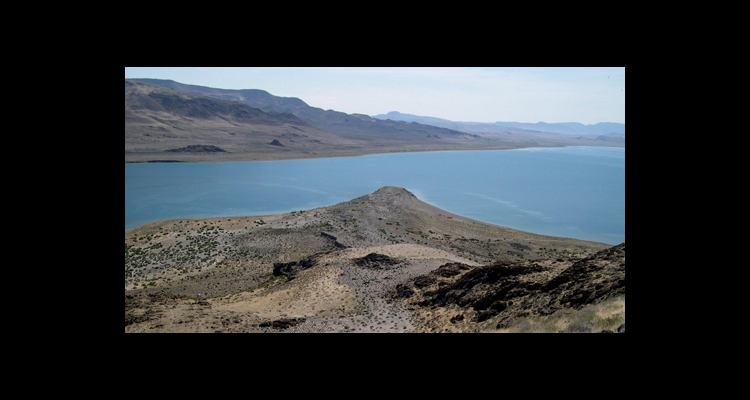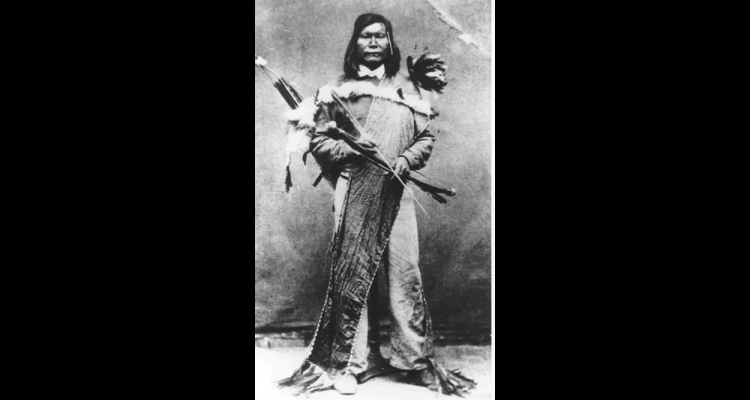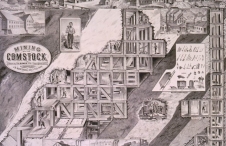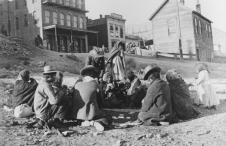Pyramid Lake War
The Pyramid Lake War of 1860 was the single greatest confrontation between American Indians and whites in Nevada's history. It was caused by the onrush of thousands of settlers to the Washoe country, lured by reports of valuable silver and gold deposits on the Comstock, combined with the lack of any effective organized government in the area. By the spring of 1860, the often unruly influx of Euro-Americans approximately equaled the Northern Paiute population in the area, impinging on their scarce resources and food supply. Incidents between the whites and Native Americans in the nearby Honey Lake area heightened tensions.
Consequently, in May 1860, a large band of Paiute Indians, along with allied Bannocks and Shoshones, met near Pyramid Lake for the annual fish run and to discuss options. The great majority of the leaders advocated war without, however, suggesting any specific course of action. Only Numanga of the Pyramid band foresaw the futility of the effort, advising against war, declaring that if there were a confrontation, "They will come like the sand in a whirlwind and drive you from your homes. You will be forced among the barren rocks of the north, where your ponies will die; where you will see the women and old men starve, and listen to the cries of your children for food."
Meanwhile, events outpaced the debate. Two brothers at Williams Station, a stage and grog stop on the Carson River, had kidnapped two American Indian sisters of about twelve years of age, molested and then hidden them. When members of their tribe discovered this, an enraged group of warriors, including the girls' father, rescued them, while in the process killing two of the Williams brothers, along with three other whites, and burning the station. When the news reached the tribal enclave at Pyramid Lake it sealed the case for war, upon which Numanga reportedly and regretfully said, "There is no longer any use for counsel; we must prepare for war."
When news of the carnage at Williams Station reached the Comstock settlements, it was immediately determined that the Indians had to be taught a lesson. The settlers perceived the non-aggressive Paiutes as mere "digger," and the prevailing mood was that the punishment would be easily administered. The universal feeling was that the venture would be a joy ride to victory over a passive enemy. Four detachments of men, totaling 105, were organized from Virginia City, Silver City, Carson City, and Genoa. Since no effective government existed in the area, this was very much a vigilante, squatter effort. Perhaps inevitably, there was no recognized, uniform command of the group, although Major William Ormsby attempted to fill that function.
It hardly turned out that way. On May 12, 1860, Numanga's army lured the motley force into a trap on the banks of the Truckee River southeast of Pyramid Lake. An estimated seventy of the white combatants died, but were it not for the advancing darkness which gave cover to the fleeing troops, probably everyone would have been killed. Major Ormsby himself was slain. This engagement resulted in the loss of more Euro-American lives than had been the case for any Native American-white confrontation for the previous sixty-nine years. It was a stunning surprise.
The survivors skedaddled as rapidly as possible back to the settlements, where panic now prevailed. A makeshift, homemade wooden cannon was improvised in Gold Hill which, in the only time it was used, blew up on itself. In Virginia City, an unfinished stone hotel became an impromptu fort. The mines completely shut down and many settlers fled the area. Since typically the settlers belittled the Northern Paiutes as fighters, and perhaps remembering the recent notorious Mountain Meadows Massacre, many ascribed the disaster to the hidden hand of Mormonism—the general feeling, as reported in a letter by Alf Doten, was that the Paiutes should be utterly exterminated and "the old arch traitor Brigham Young hanged."
A telegraph to California resulted in the arrival of 544 volunteer soldiers from California and the Washoe Country under the capable leadership of Colonel John Coffee Hays. They were joined by 207 regulars of the United States army, led by Captain Joseph Stewart. This was probably a superior force to what the Native Americans could muster. On June 2, 1860, the Paiute and white forces met in a second battle, fought near where the previous one had occurred. For safety's sake, American Indian women and children had been hustled off to the Black Rock Desert. After three hours of fierce fighting, the battle seemed a draw. Only three whites were killed, and the number of Native American losses was unknown, but probably light. Although the battle had been closely fought, the Paiute forces slipped away that night, leaving the strategic victory in the hands of the whites.
Thus the Comstock area was put solidly under Euro-American control, and never again would Native American forces be able to muster any effective resistance to white population incursions.



